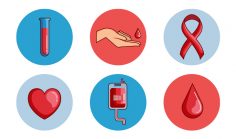What are Nuclear scans (also called Radioisotope scans or Radionuclide scans)?:
Nuclear scans are medical imaging scans that utilize radioactive materials, specially designed cameras, and computers to see your body’s internal structures, and evaluate how effectively they’re functioning.
How nuclear scans work:
Patients are given a radioactive material, called a radiotracer or radiopharmaceutical, by injection, inhalation, or swallowing. This material concentrates in the area of the body being examined, and there, it gives off a small amount of energy. Using special cameras (gammas) that detect this energy, and computers to compile the images taken by the camera, specialists can create detailed pictures of a patient’s tissues and organs, and assess their function.
When are nuclear scans used:
Nuclear scans can help physicians detect cancer, infections, and injuries, as well as assess a person’s heart and lung function. The most common nuclear scans include:
- Bone scans (this type of scan is also called skeletal scintigraphy), which uses a small amount of radioactive material to detect various bone diseases and disorders
- Hepatobiliary (HIDA) scans, which examine the liver, gallbladder, and bile ducts
- Lymphoscintigraphy, a special type of nuclear medicine imaging technique, which provides pictures called scintigrams of the lymphatic
- Nuclear heart scans
- Nuclear stress tests which check for heart function, structure, and possible damage to the heart or arteries
- Positron Emission Tomography – Computed Tomography (PET/CT) scans, which use tiny amounts of radioactive material to find and treat a variety of diseases, including some cancers, heart disease, endocrine, gastrointestinal, and neurological abnormalities.
- Radionuclide Cystogram scan (Bladder scan) which uses a radioactive solution to diagnose bladder problems
- Renal cyntigraphy (Renal Imaging or Renal Scanning), which uses a small amount of radioactivity to assess the function and structure of the kidneys
- Scintimammography, in which a small amount of radioactive material is introduced to a breast, then scanned to take a better look at any abnormality seen on a regular mammogram
- Single photo emission computerized tomography (SPECT), which uses a camera and radioactive material to create 3D images of the body’s internal organs
- Thyroid Scan and Uptake, which uses radioactive material to asses the thyroid gland’s position, size, and structure
Possible complications of nuclear scans:
Nuclear scans rarely cause any discomfort or side effects.
Possible complications of materials used to enhance nuclear scans:
As part of a nuclear scan, you will be given a radiotracer—a substance containing a small amount of radioactive material. It will help highlight areas your physician wishes to examine. Side effects vary by the way in which it’s administered:
- By mouth: You may feel a slightly strange taste.
- By inhalation: It should feel no different than breathing normal air.
- By catheter: The catheter may cause some temporary discomfort.













